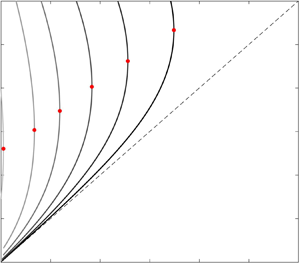Article contents
Linear stability and nonlinear dynamics in a long-wave model of film flows inside a tube in the presence of surfactant
Published online by Cambridge University Press: 08 December 2020
Abstract

A long-wave model based on lubrication theory is developed for the flow of a viscous liquid film lining the interior of a tube in the presence of an insoluble surfactant on the interface; no thin-film assumption is made. Linear stability analysis identifies two modes; in the absence of base flow, the ‘interface’ mode is the only unstable mode. The growth rates of this mode serve as an accurate predictor of how surfactant concentration increases plug formation time, and the effects of film thickness on this increase are quantified. In the presence of base flow, both the interface mode and ‘surfactant’ mode may be unstable, resulting in a richer variety of free-surface dynamics. In previous work, turning points in families of travelling wave solutions for a falling viscous film lining the interior of a vertical tube with a clean interface have been shown to be a good indicator of  $h_c$, the critical thickness past which plugs may form, and this approach is adapted here for flow with surfactant. It is found that turning points in branches of travelling waves that arise from an unstable surfactant mode give an estimate of
$h_c$, the critical thickness past which plugs may form, and this approach is adapted here for flow with surfactant. It is found that turning points in branches of travelling waves that arise from an unstable surfactant mode give an estimate of  $h_c$, provided the interface mode is linearly stable. When both modes are unstable, interpretation of these turning points as they relate to plug formation is more complicated. The study concludes by examining the impact of film thickness on growth rates and travelling wave solutions for core–annular flow with surfactant.
$h_c$, provided the interface mode is linearly stable. When both modes are unstable, interpretation of these turning points as they relate to plug formation is more complicated. The study concludes by examining the impact of film thickness on growth rates and travelling wave solutions for core–annular flow with surfactant.
- Type
- JFM Papers
- Information
- Copyright
- © The Author(s), 2020. Published by Cambridge University Press
References
REFERENCES
- 11
- Cited by



